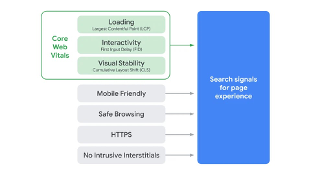Get excited – Google recently announced a new ranking signal: the Page Experience update. The good news? You have time to prepare as it won’t be rolled out until 2021.
This is another one for the good guys. It’s designed to give bonus points to those sites that focus on delivering a great experience to their audience, and to demote sites that don’t.
But hasn’t Google always considered how people are feeling about your site? I’ve always said what Google Analytics can measure, Google can take into account, such as:
- Time spent on site
- Average number of pages visited
- Bounce rate
- Pogosticking (coming to your site and immediately hitting the back button)
- New and returning customers
- Events triggered (scrolling down, watching videos, interacting with content on a page), etc.
What were once “indirect” ranking signals that measured satisfaction are now getting a lot more direct.
The other piece of good news is Google is helping us address this now with a set of new tools.
Core Web Vitals – Break-Down for Marketers
Go ahead and look in your Google Search Console account now. If you haven’t visited your account in a while, expect to see a few interesting (overwhelming?) changes.
One of the recent changes is the addition of the “Core Web Vitals” report.

Core web vitals are individual measurements of essential elements of user experience on a page, such as:
- Loading performance – Google says a good experience means loading performance, AKA “largest contentful paint” should occur within 2.5 seconds
- Interactivity – the lower the better; pages with a great UX should have a low score, less than 100 milliseconds (AKA “First Input Delay”). This metric measures the time it takes for a user to interact with your site to the time the browser responds to that interaction.
- Visual stability – have you ever been reading a page, or about to click a link, and the content shifts and moves down, causing you to click on an ad or something else annoying? Yeah. That’s the worst. Happens all the time on sites I click on from Pinterest. Let’s all thank Google for measuring this one. Google says a good UX should maintain movement, or “Cumulative Layout Shift” of less than .1.
These 3 metrics will be combined with existing metrics (mobile friendliness, https, and interstitial/pop-up best practices) to determine your overall page experience signal.

The Importance of This Google Update
It (hopefully) should not come as a surprise, that this update means speed, performance, and “annoyance factor” of not only your website as a whole, but individual pages, matter.
And two final important notes from Google:
- This one should bring a sigh of relief…: “While all of the components of page experience are important, we will prioritize pages with the best information overall, even if some aspects of page experience are subpar. A good page experience doesn’t override having great, relevant content.”
- ….except for those of you in competitive industries or with equally savvy competitors: “However, in cases where there are multiple pages that have similar content, page experience becomes much more important for visibility in Search.”
The golden rule of SEO: if you’re targeting competitive keywords, or in a competitive niche, you’re SEO house needs to be in tip-top shape.
These changes should move us in the right direction. And we officially have half a year, at a minimum, before this ranking factor formally rolls out. Don’t say you didn’t have sufficient warning. Now – go set a time to check your Search Console and get with your developer!
SEO |